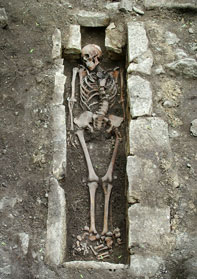Historical Osteology

Osteology is the study of bones, and within the subject of Historical Osteology, you study the skeleton material found in connection with archaeological excavations.
You investigate the bones of human beings, their domestic animals and hunted game. This source material can answer many questions on the living environments of human beings, their living conditions and cultures in the past.
As a student of historical osteology, you therefore learn how to read the traces of the lives of humans and animals in the bones they leave behind. Osteologists can often answer questions concerning gender, age at death, body size, diet, patterns of behaviour, injuries and diseases. The study programme is both practical and theoretical; it also strongly emphasises ethical perspectives.
The subject of historical osteology has applications within archaeology, historical archaeology, marine archaeology, and within the subject of archaeology and ancient history. Osteological methods are also used in geology, biology, odontology, veterinary medicine and medicine.
The study of historical osteology therefore has close scholarly contacts with these disciplines and is thus cross-disciplinary in nature. Internationally, historical osteology corresponds to two disciplines, namely biological anthropology and zooarchaeology. Via the department’s international contacts and exchanges, there are also opportunities for studies abroad.
